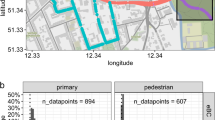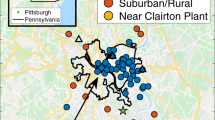Abstract
Exposure to high levels of traffic-generated particles may pose risks to human health; however, limited measurement has been conducted at homes near highways. The purpose of this study was to characterize differences between indoor and outdoor particle number concentration (PNC) in homes near to and distant from a highway and to identify factors that may affect infiltration. We monitored indoor and outdoor PNC (6–3000 nm) for 1–3 weeks at 18 homes located <1500 m from Interstate-93 (I-93) in Somerville, MA (USA). Median hourly indoor and outdoor PNC pooled over all homes were 5.2 × 103 and 5.9 × 103 particles/cm3, respectively; the median ratio of indoor-to-outdoor PNC was 0.95 (5th/95th percentile: 0.42/1.75). Homes <100 m from I-93 (n=4) had higher indoor and outdoor PNC compared with homes >1000 m away (n=3). In regression models, a 10% increase in outdoor PNC was associated with an approximately equal (10.8%) increase in indoor PNC. Wind speed and direction, temperature, time of day and weekday were also associated with indoor PNC. Average mean indoor PNC was lower for homes with air conditioners compared with homes without air conditioning. These results may have significance for estimating indoor, personal exposures to traffic-related air pollution.
This is a preview of subscription content, access via your institution
Access options
Subscribe to this journal
Receive 6 print issues and online access
$259.00 per year
only $43.17 per issue
Buy this article
- Purchase on Springer Link
- Instant access to full article PDF
Prices may be subject to local taxes which are calculated during checkout



Similar content being viewed by others
References
Laden F, Schwartz J, Speizer FE, Dockery DW . Reduction in fine particulate air pollution and mortality: extended follow-up of the Harvard Six Cities study. Am J Respir Crit Care Med 2006; 173 (6): 667–672.
McConnell R, Islam T, Shankardass K, Jerrett M, Lurmann F, Gilliland F et al Childhood incident asthma and traffic-related air pollution at home and school. Environ Health Perspect 2010; 118 (7): 1021–1026.
Kunzli N, Jerrett M, Garcia-Esteban R, Basagana X, Beckermann B, Gilliland F et al Ambient air pollution and the progression of atherosclerosis in adults. PLoS One 2010; 5 (2): e9096.
Pope CA, Ezzati M, Dockery DW . Fine-particulate air pollution and life expectancy in the United States. N Engl J Med 2009; 360 (4): 376–386.
Morawska L, Thomas S, Bofinger N, Wainwright D, Neale D . Comprehensive characterization of aerosols in a subtropical urban atmosphere: Particle size distribution and correlation with gaseous pollutants. Atmos Environ 1998; 32 (14-15): 2467–2478.
Sioutas C, Delfino RJ, Singh M . Exposure assessment for atmospheric ultrafine particles (UFPs) and implications in epidemiologic research. Environ Health Perspect 2005; 113 (8): 947–955.
Zhang JJ, McCreanor JE, Cullinan P, Chung KF, Ohman-Strickland P, Han IK et al Health effects of real-world exposure to diesel exhaust in persons with asthma. Res Rep Health Eff Inst 2009; 138: 5–109 discussion 11-23.
Brugge D, Durant JL, Rioux C . Near-highway pollutants in motor vehicle exhaust: a review of epidemiologic evidence of cardiac and pulmonary health risks. Environ Health 2007; 6: 23.
Calderón-Garcidueñas L, Mora-Tiscareño A, Ontiveros E, Gómez-Garza G, Barragán-Mejía G, Broadway J et al Air pollution, cognitive deficits and brain abnormalities: A pilot study with children and dogs. Brain Cogn 2008; 68 (2): 117–127.
Hertel S, Viehmann A, Moebus S, Mann K, Brocker-Preuss M, Mohlenkamp S et al Influence of short-term exposure to ultrafine and fine particles on systemic inflammation. Eur J Epidemiol 2010; 25 (8): 581–592.
Karner AA, Eisinger DS, Niemeier DA . Near-roadway air quality: synthesizing the findings from real-world data. Environ Sci Technol (Review) 2010; 44 (14): 5334–5344.
HEI Traffic-related air pollution: a critical review of the literature on emissions, exposure, and health effects. Special Report. Boston: Health Effects Institute 2010 January 12 2010 Report No.: Special Report 17 Contract No.: Special Report 17.
Zeka A, Sullivan JR, Vokonas PS, Sparrow D, Schwartz J . Inflammatory markers and particulate air pollution: characterizing the pathway to disease. Int J Epidemiol 2006; 35 (5): 1347–1354.
Ruckerl R, Greven S, Ljungman P, Aalto P, Antoniades C, Bellander T et al Air pollution and inflammation (interleukin-6, C-reactive protein, fibrinogen) in myocardial infarction survivors. Environ Health Perspect 2007; 115 (7): 1072–1080.
Ruckerl R, Ibald-Mulli A, Koenig W, Schneider A, Woelke G, Cyrys J et al Air pollution and markers of inflammation and coagulation in patients with coronary heart disease. Am J Respir Crit Care Med 2006; 173 (4): 432–441.
Klepeis NE, Nelson WC, Ott WR, Robinson JP, Tsang AM, Switzer P et al The National Human Activity Pattern Survey (NHAPS): a resource for assessing exposure to environmental pollutants. J Expo Anal Environ Epidemiol 2001; 11 (3): 231–252.
McAuley TR, Fisher R, Zhou X, Jaques PA, Ferro AR . Relationships of outdoor and indoor ultrafine particles at residences downwind of a major international border crossing in Buffalo, NY. Indoor Air 2010; 20 (4): 298–308.
Zhu Y, Hinds WC, Krudysz M, Kuhn T, Froines JR, Sioutas C . Penetration of freeway ultrafine particles into indoor environments. J Aerosol Sci 2004; 36: 303–322.
Long CM, Suh HH, Catalano PJ, Koutrakis P . Using time- and size-resolved particulate data to quantify indoor penetration and deposition behavior. Environ Sci Technol 2001; 35 (10): 2089–2099.
Cyrys J, Pitz M, Bischof W, Wichmann HE, Heinrich J . Relationship between indoor and outdoor levels of fine particle mass, particle number concentrations and black smoke under different ventilation conditions. J Expo Anal Environ Epidemiol 2004; 14 (4): 275–283.
Arhami M, Polidori A, Delfino RJ, Tjoa T, Sioutas C . Associations between personal, indoor, and residential outdoor pollutant concentrations: implications for exposure assessment to size-fractionated particulate matter. J Air Waste Manag Assoc 2009; 59 (4): 392–404.
Bhangar S, Mullen NA, Hering SV, Kreisberg NM, Nazaroff WW . Ultrafine particle concentrations and exposures in seven residences in northern California. Indoor Air 2011; 21 (2): 132–144.
Abt E, Suh HH, Allen G, Koutrakis P . Characterization of indoor particle sources: A study conducted in the metropolitan Boston area. Environ Health Perspect 2000; 108 (1): 35–44.
MPO B Appendix B: existing data. Boston 2009 Available from http://www.bostonmpo.org/bostonmpo/4_resources/1_reports/1_studies/2_highway/route_28/Appendix-B.pdf.
Fuller CH, Brugge D, Williams PL, Mittleman MA, Durant JL, Spengler JD . Estimation of ultrafine particle concentrations at near-highway residences using data from local and central monitors. Atmos Environ 2012; 57: 257–265.
Houseman EA, Ryan L, Levy JI, Spengler JD . Autocorrelation in real-time continuous monitoring of microenvironments. J Appl Stat 2002; 29 (6): 855–872.
Zwack LM, Paciorek CJ, Spengler JD, Levy JI . Modeling spatial patterns of traffic-related air pollutants in complex urban terrain. Environ Health Perspect 2011; 119 (6): 852–859.
Kearney J, Wallace L, MacNeill M, Xu X, VanRyswyk K, You H et al Residential indoor and outdoor ultrafine particles in Windsor, Ontario. Atmos Environ 2011; 45 (40): 7583–7593.
Abt E, Suh HH, Catalano P, Koutrakis P . Relative contribution of outdoor and indoor particle sources to indoor concentrations. Environ Sci Technol 2000; 34 (17): 3579–3587.
Hahn I, Brixey LA, Wiener RW, Henkle SW . Parameterization of meteorological variables in the process of infiltration of outdoor ultrafine particles into a residential building. JEM 2009; 11 (12): 2192–2200.
Brown KW, Sarnat JA, Suh HH, Coull BA, Koutrakis P . Factors influencing relationships between personal and ambient concentrations of gaseous and particulate pollutants. Sci Total Environ 2009; 407 (12): 3754–3765.
Koponen I, Asmi A, Keronen P, Puhto K, Kulmala M . Indoor air measurement campaign in Helsinki, Finland 1999 - the effect of outdoor air pollution on indoor air. Atmos Environ 2001; 35 (8): 1465–1477.
Clark NA, Allen RW, Hystad P, Wallace L, Dell SD, Foty R et al Exploring variation and predictors of residential fine particulate matter infiltration. Int J Environ Res Public Health 2010; 7 (8): 3211–3224.
Ebelt ST, Wilson WE, Brauer M . Exposure to ambient and nonambient components of particulate matter: a comparison of health effects. Epidemiology 2005; 16 (3): 396–405.
Wilson WE, Brauer M . Estimation of ambient and non-ambient components of particulate matter exposure from a personal monitoring panel study. J Expo Sci Environ Epidemiol 2006; 16 (3): 264–274.
Acknowledgements
We would like to thank the members of the CAFEH Steering Committee including Edna Carrasco, Mario Davila, Baolian Kuang, Bart Laws, Michelle Liang, Ellin Reisner and Wig Zamore for their valuable contributions. We also thank the project manager Don Meglio and field team members Kevin Stone and Marie Manis for their dedication to the project. We are also grateful to José Vallarino for his assistance with fieldwork. This research was supported by a grant from the National Institute of Environmental Health Sciences (Grant No. ES015462; Brugge, PI). Support for Christina H. Fuller’s pre-doctoral work was provided by a Molecular and Integrative Physiological Sciences Training Grant (T32 HL 007118).
Author information
Authors and Affiliations
Corresponding author
Ethics declarations
Competing interests
The authors declare no conflict of interest.
Additional information
Supplementary Information accompanies the paper on the Journal of Exposure Science and Environmental Epidemiology website
Supplementary information
Rights and permissions
About this article
Cite this article
Fuller, C., Brugge, D., Williams, P. et al. Indoor and outdoor measurements of particle number concentration in near-highway homes. J Expo Sci Environ Epidemiol 23, 506–512 (2013). https://doi.org/10.1038/jes.2012.116
Received:
Accepted:
Published:
Issue Date:
DOI: https://doi.org/10.1038/jes.2012.116
Keywords
This article is cited by
-
Fireworks induced quasi-ultrafine particle number concentration and size-resolved elemental distribution in megacity Delhi
Arabian Journal of Geosciences (2022)
-
Metabolomic assessment of exposure to near-highway ultrafine particles
Journal of Exposure Science & Environmental Epidemiology (2019)
-
Occupational exposures and determinants of ultrafine particle concentrations during laser hair removal procedures
Environmental Health (2017)
-
Sources of airborne microorganisms in the built environment
Microbiome (2015)
-
Effect of time-activity adjustment on exposure assessment for traffic-related ultrafine particles
Journal of Exposure Science & Environmental Epidemiology (2015)



